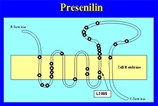Alzheimer plot thickens — plaque regulator discovered
 Researchers led by the University of Toronto's Peter St. George-Hyslop have isolated a key protein involved in the degeneration of nerve cells in Alzheimer's disease, according to a study published in this week's issue of Nature. The new protein, called nicastrin (in honor of the Italian village, Nicastro, where the quest for the Alzeheimer gene began some 40 years ago), binds to presenilin 1 and presenilin-2, as well as the b-amyloid precursor protein, and appears to play a role in amyloid b-peptide production.
Researchers led by the University of Toronto's Peter St. George-Hyslop have isolated a key protein involved in the degeneration of nerve cells in Alzheimer's disease, according to a study published in this week's issue of Nature. The new protein, called nicastrin (in honor of the Italian village, Nicastro, where the quest for the Alzeheimer gene began some 40 years ago), binds to presenilin 1 and presenilin-2, as well as the b-amyloid precursor protein, and appears to play a role in amyloid b-peptide production."We've found a completely unknown protein that's involved in the biochemical processing of the beta-amyloid precursor protein which causes Alzheimer's disease," said St. George-Hyslop, director of the Centre for Research in Neurodegenerative Diseases (CRND) in the University of Toronto's Faculty of Medicine and a neurologist at the University Health Network. "This opens the way for the development of drugs that will target the new protein to manipulate the process that leads to the disease."
The group set out to find proteins that adhere to presenilin 1 and presenilin 2, already known to be involved in Alzheimer's. Mutations in these proteins cause abnormal processing of b-amyloid precursor protein, ultimately leading to plaque deposition and Alzheimer's disease. Until now, the exact mechanism by which presenilin mutations altered b-amyloid precursor protein processing and caused Alzheimer's was unclear.

The researchers found that nicastrin binds to the b-amyloid precursor protein and regulates the production of the potentially dangerous amyloid b-peptide fragment.
"More importantly," St. George-Hyslop said, "we discovered a way to manipulate nicastrin to either increase or decrease the production of the harmful amyloid beta-peptide. This could lead to new treatments that will target nicastrin to prevent the overproduction of this neurotoxic protein."
"Nicastrin is clearly a very important component of the cellular machinery underlying Alzheimer's and has several features which suggest that it might be used as a target for the development of new drugs for this disease," said co-author Paul Fraser of the CRND.
It is not yet clear, St. George-Hyslop said, whether genetic variation in nicastrin is associated with an inherited susceptibility to Alzheimer's disease.
St. George-Hyslop and his research team in 1995 discovered the presenilin genes responsible for the most severe forms of early-onset Alzheimer's. He is the recipient of the Medical Research Council's prestigious Michael Smith Award and was named to Maclean's magazine's 1998 Honor Roll.
Funding was provided by the Canadian Institutes of Health Research, the Alzheimer Society of Ontario, the Howard Hughes Medical Institute, and other international agencies.
For more information: Peter St George Hyslop, Centre for Research in Neurodegenerative Diseases, The University Health Network, Toronto Western Hospital, Toronto, ON, Canada, M5S 3H2. Tel: 416-978-7461. Fax: 416-978-1878. Email: p.hyslop@utoronto.ca.
Edited by Laura DeFrancesco
Managing Editor, Bioresearch Online
